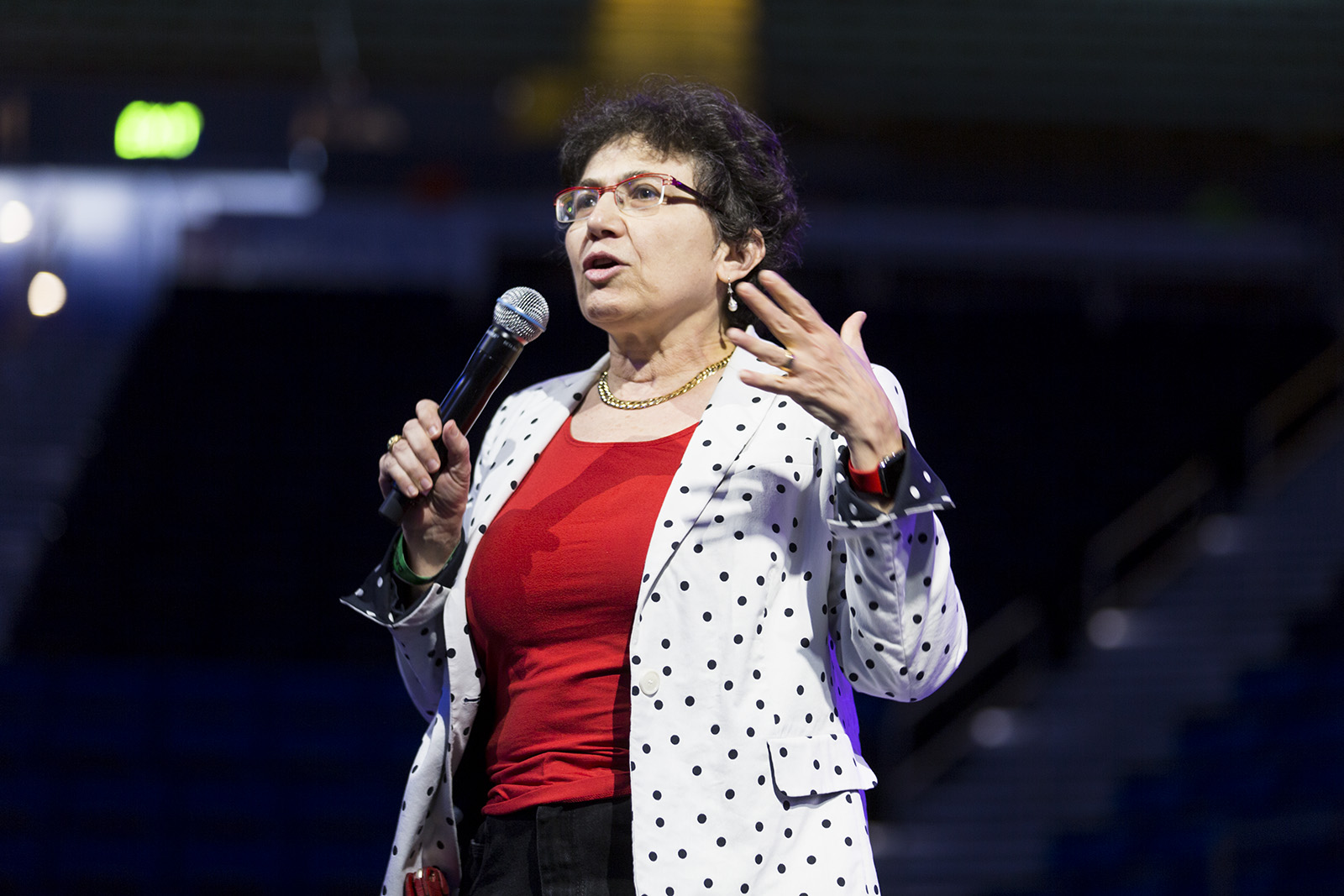Dance Marathon creates increasing hope for cure for pediatric AIDS

Dr. Grace Aldrovandi spoke about the progress made in research and treatment of pediatric AIDS during an address to participants at Dance Marathon. (Erin Gong/Daily Bruin)
By Sharon Zhen
April 8, 2017 8:52 p.m.
HIV is not a death sentence anymore, an HIV-positive speaker at this year’s Dance Marathon said. In the last few decades, researchers have made progress in treatment and prevention of HIV.
“If you are HIV-positive, you are going to live a healthy life if you take care of yourself,” said Jake Glaser, a Elizabeth Glaser Pediatric AIDS Foundation founder’s son and an ambassador for the organization.
However, there is not yet a cure for the disease and there are still barriers to accessing treatment options.
About 400 children become infected with HIV per day, and 90 percent of those children are infected by mother-to-child transmission, according to the Pediatric AIDS Coalition. Every year, some of the funds raised by students participating in Dance Marathon go to aiding advancements in eliminating pediatric HIV and AIDS, such as research on preventing mother-to-child transmissions.
HIV occurs when the human immunodeficiency virus attacks a person’s immune system by destroying certain white blood cells. When those cells are drastically reduced, HIV becomes acquired immunodeficiency syndrome. Though there’s no known cure for HIV, antiretroviral therapy help stop its progression and prevent its transmission, according to PAC.
Grace Marie Aldrovandi, a translational physician and scientist in the department of pediatric infectious diseases at UCLA who spoke at this year’s Dance Marathon, said research on pediatric AIDS has been a success story thus far.
“When I started as a doctor, adults and children were dying from HIV all the time,” Aldrovandi said. “But now when I treat children with pediatric AIDS, they are able to continue with their life, and I see some of them, they grow up to be taller than me and some are even going to medical school.”
Aldrovandi said that though doctors are still trying to find a cure for the disease, research findings in pediatric AIDS have helped develop solutions, so that the average lifetime for someone with AIDS has increased from 8-10 years to 60-79 years. She added progress in treating pediatric AIDS has occurred because of clinical trials on pregnant women and babies, despite protests by people who are concerned about the risks.
Peyton Beatrice, external marketing strategist of PAC at UCLA, said pediatric AIDS is preventable through testing, treatment and safe childbirth. She added antiretroviral therapy for the pregnant mother can reduce the chance of HIV transmission to as low as 5 percent.
Carolyn Francis, president of PAC at UCLA, said that in her four years of college she has noticed progress in the fight against pediatric AIDS.
“Four years ago when I was a freshman, around a thousand babies were infected every day,” Francis said. “Now every day, 400 children are infected with HIV.”
Aldrovandi said that when she was young, people did not know much about HIV and finding a cure seemed unthinkable.
She said there were interesting theories and cures to HIV, but antiretroviral vastly improved peoples’ health.
Aldrovandi added that antiretroviral drugs were so effective that when she was in Africa, many families did not believe how effective the drugs actually were. Antiretroviral drugs help control the virus and prevent its transmission.
“They got healthier, and when they went back to their villages, they would sometimes get stoned because people thought they were ghosts,” she said.
Francis said she thinks there are still accessibility problems despite the research advancements.
“Accessibility to antiretroviral drugs remains an important barrier, particularly in sub-saharan Africa, where the disease is prevalent,” Aldrovandi said. “Because of activism, companies are now giving the drugs for free or at a very low cost.”
UCLA has raised almost $5 million in the fight against HIV and AIDS since Dance Marathon was first held in 2002. Glaser hopes that others, like UCLA students, will continue to work toward a cure for HIV and AIDS.
Contributing reports from Rupan Bharanidaran, Daily Bruin staff.


